Ticks and Tickborne Diseases of Utah
July 2023
Kate Richardson, Arthropod Diagnostician • Ryan Davis, Arthropod Diagnostician (No longer at USU) • Ricardo Ramirez, Entomologist (No longer at USU)
Quick Facts
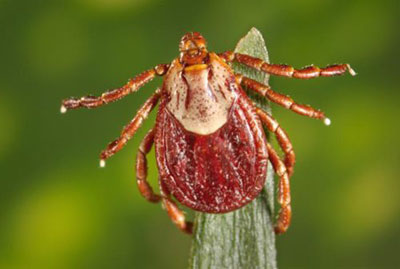
Fig. 1. Rocky Mountain wood tick female adult. Image
courtesy of Centers for Disease Control and Prevention
(CDC) .
- The primary tick attaching to humans and pets in Utah is the Rocky Mountain wood tick, which can transmit Colorado tick fever.
- The only human-attaching tick capable of transmitting Lyme disease in Utah is the western blacklegged tick, and the likelihood of encountering one is very low.
- Ticks are most frequently encountered from snowmelt through mid-July in Utah.
- To protect yourself against tick-borne illnesses, always conduct a thorough tick check after being in tick habitat.
Ticks are arachnids (related to spiders and mites) that feed on the blood of animals. They are most known for their potential to transmit disease to humans and other animals. Both hard ticks (Ixodidae) and soft ticks (Aragasidae) may be encountered in Utah.

Fig. 2. Typical tick habitat in Utah
The Rocky Mountain wood tick (Dermacentor andersoni; Fig. 1) is the most commonly encountered tick for humans and pets. The brown dog tick (Rhipicephalus sanguineus) may occasionally be brought into homes on infested dogs or animals. Less frequently encountered ticks include the winter fern tick (D. albipictus) and the western blacklegged tick (Ixodes pacificus).
In Utah, ticks are usually found on grasses, low plants, and sagebrush, waiting to attach to a host (Fig. 2). Ticks do not jump or fly to find hosts. Many species of ticks occur in Utah, but most live in close association with their hosts and would never encounter humans. Ticks are of medical concern because pathogens (bacteria, viruses or protozoa) can be transmitted when infected ticks feed on humans.
Life Cycle
Hard ticks (Ixodidae) have four distinct life stages: egg, larva, nymph, and adult. Adult and nymphal ticks have eight legs, while newly hatched larvae have six legs and are very tiny. Visually, ticks appear to have one body segment, but two distinct segments exist, the gnathosome (mouthparts) and the idosome (body). Ticks range in size from 2 mm to 20 mm depending on the life stage and species.
The number of hosts a tick will attach to depends on the tick species. Three-host ticks will attach to three different animal hosts during their life, while the one-host ticks attach to one host and remain on that host throughout their lives. Two-host ticks occur on one host as immatures and on another host in the adult stage. Ticks must take a blood meal between each life stage to molt and reproduce successfully.
Mating occurs on-host, and the female will drop to the ground to lay eggs. Egg laying can take weeks to complete, and eggs can number in the thousands. Female hard ticks will die after completing egg-laying. After hatching, two- and three-host tick larvae will seek rodents, lizards, and other small hosts, while one-host ticks will search for their primary host species. In Utah, humans and pets mostly come in contact with three-host ticks in the nymph or adult stage while seeking larger mammalian hosts.
Hard Tick Species
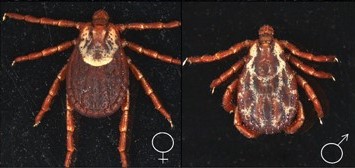
Fig. 3. Rocky Mountain wood tick adult female (left) and adult male (right).
The Rocky Mountain wood tick (Dermacentor andersoni; Fig. 3) is the most commonly encountered tick in Utah. It is a brown three-host tick but can become grayish when engorged. They have an oval-shaped body that is somewhat flattened from top to bottom. Unengorged adult females are about 1/8 inch, while males are about 1/16 to 1/4 inch. Engorged ticks can be 5/8 inch long and 1/2 inch wide.
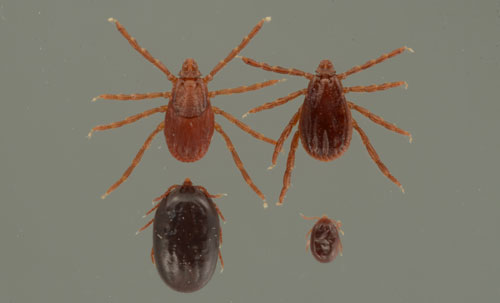
Fig. 4. Brown dog tick life stages: adult female (top left); adult male (top right); engorged nymph (bottom left); and engorged larva (bottom right). Image courtesy of Lyle J. Buss, University of Florida.
The brown dog tick (Rhipicephalus sanguineus; Fig. 4) is also a three-host tick. However, they typically only develop on dogs and are only commonly found where dogs are present and kept in enclosed areas.
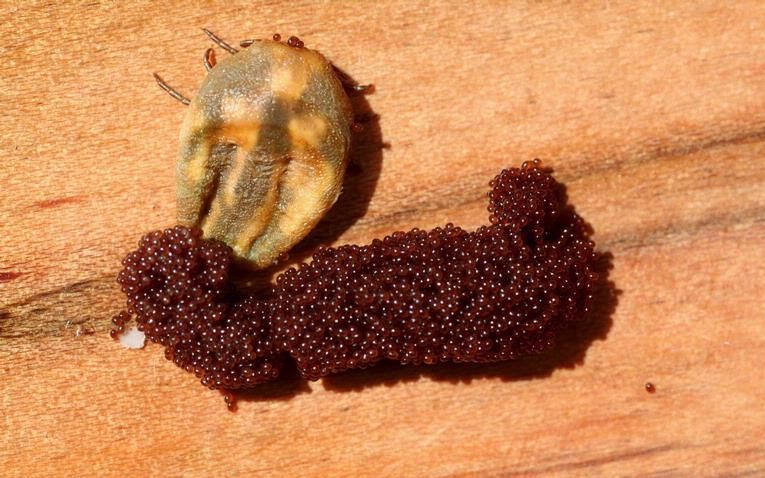
Fig. 5. Female winter fern tick with eggs. Image courtesy of Whitney Cranshaw, Colorado State University, Bugwood.org.
The winter fern tick (Dermacentor albipictus; Fig. 5) is a one-host tick and will remain on its large mammal host, commonly elk, moose, horse, etc., for all feeding stages of its life until it drops from the animal in the spring to lay eggs.
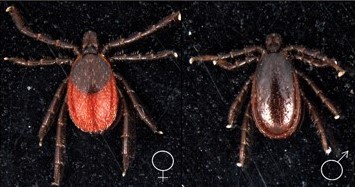
Fig. 6. Western blacklegged tick adult female (left) and adult male (right)
Western blacklegged ticks (Ixodes pacificus; Fig. 6) are not commonly encountered in Utah, and while they can transmit Lyme disease, they are not known to do so in Utah. Their very small body size, reddish body color, and black legs can distinguish them from other ticks.

Fig. 7. Tick habitat containing (Juniperis spp.), big sagebrush (Artemisia tridentata), black sagebrush (Artemisia nova), and grasses
Tick Habitat
In Utah, the most likely time to encounter ticks is from snowmelt through mid-July, but it can vary by year, elevation, geographic location, and climactic conditions. In general, the moist spring season promotes tick activity, while hot temperatures and dry summer conditions inhibit tick activity. Ticks can also become active again in the fall.
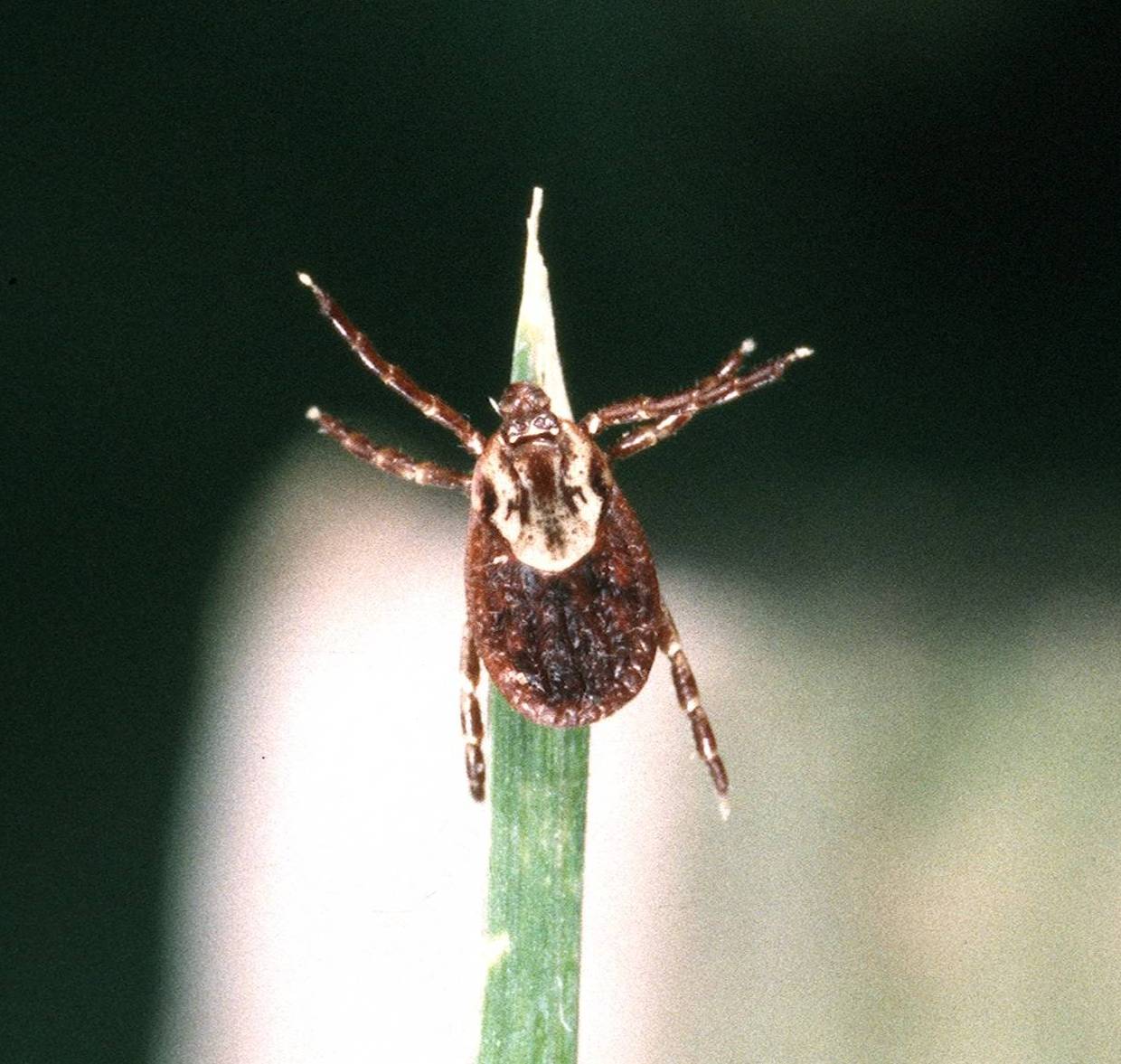
Fig. 8. Adult tick "questing" by waiting on
vegetation for a passing host. image
courtesy Jim Occi, BugPics, Bugwood.org.
Ticks typically concentrate on areas where their animal hosts commonly travel. They are usually found from ground level to 3 feet above the ground in grass, low plants, and brush along the edges of fields and woodlands (Fig. 7).
Utah’s commonly encountered ticks find hosts by “questing.” Questing involves climbing vegetation and waiting for a host (Fig. 8). The tick senses a passing host,
extends its legs and grabs on as the host brushes against the vegetation. Once on the host, the tick will begin searching for a suitable, preferably protected, feeding site. Ticks will use host odors and other physical stimuli to determine host suitability before feeding.
Tick Feeding

Fig. 9. Tick engorgement stages from unfed (left) to
fully engorged (right)
Hard ticks don’t simply bite, they attach. Scissor-like mouthparts (chelicerae) are used to cut into the skin and the barbed hypostome (straw-like mouthpart) is inserted. The tick secrets a numbing agent in the saliva as the hypostome pushes into the skin, so bites are typically painless. When the mouthparts are in place, hard ticks secrete a cement-like substance that will help anchor the tick to the host’s skin. This process can take from 1 to 2 days. After the cement hardens, ticks become very difficult to remove.
Once firmly in place, a tick will secrete antihistamines, anticoagulants and other enzymes to promote blood feeding. Hard ticks’ bodies grow to accommodate their blood meal as they become engorged (Fig. 9). Because of this, hard ticks will stay attached to the host for 2 to 3 days as a larva and up to 2 weeks for adult females. When feeding, adult females can increase their body weight 100-120 times the pre-feeding weight. During the feeding process, diseases can be transmitted from the tick to humans or other animals.
Soft Ticks

Fig. 10. Soft ticks (Ornithodorous parkeri). Image courtesy of Jim Occi, BugPics, Bugwood.org.
Humans less frequently encounter soft ticks (Argassidae) which are capable of transmitting diseases to humans in Utah. The name “soft tick” refers to this group’s lack of a scutum, or the hard plate that covers the back of the hard tick body (Fig. 10).
Soft ticks have four life stages (egg, larva, nymph, and adult). They differ from hard ticks in that they have multiple (three to five) nymph stages, whereas hard ticks only have one nymph stage. Soft ticks may live from 10-20 years, largely due to their ability to survive long periods without feeding.
Another primary difference between soft and hard ticks is how they feed. Hard ticks attach from a few days to a few weeks. Soft ticks feed more like bed bugs, actively finding prey and feeding in less than 1 hour. During feeding, soft ticks will have a tenfold increase in their body weight.
Soft ticks mate off-host, usually in vegetation or in hiding places in their host’s nest or roost. Unlike hard ticks, soft ticks can mate multiple times and do not have to feed each time to produce viable eggs. Typically, batches of eggs (up to 500) are laid multiple times.
In Utah, two soft tick species may transmit diseases. Ornithodorous parkeri may transmit tick-borne relapsing fever (Borrelia parkeri) to humans, though encountering this tick would be a rare event. O. parkeri habitat includes burrows of prairie dogs, ground squirrels, and burrowing owls in basins and valleys. O. hermsi may transmit Borrelia hermsii and prefers coniferous forests in mountainous regions at higher elevations.
Tick Safety
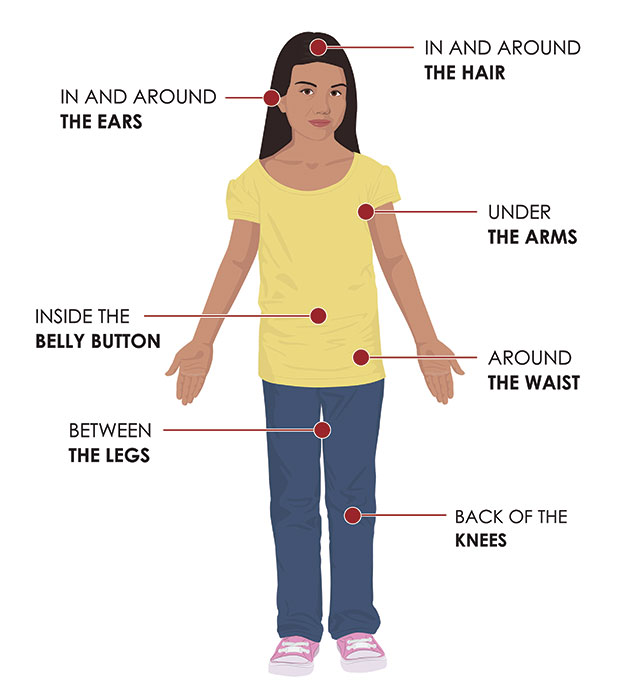
Fig. 11. Areas to inspect when completing a tick check. Image
courtesy of Centers for Disease Control and Prevention (CDC) .
Prevention is the best way to avoid ticks and their potential pathogens. Consider these tips to avoid coming in contact with ticks:
- Avoid grassy, bushy and sage-brushy areas along edges of woodlands and fields, especially from March to mid-July.
- Wear long pants and long-sleeved shirts. Tuck shirts into pants and pants into socks. Apply tick repellant to clothing before entering tick habitat.
- Wear light-colored clothes to make it easier to detect and remove ticks.
Always complete a thorough tick check after leaving tick habitat. Ticks can often be found in the armpit, waistline,
belly button, scalp, and crotch areas (Fig. 11).
Ticks may take 2 hours or longer to find a suitable feeding site and even longer to fully attach. This gives you time to find and remove them from yourself, your children, and your pets. Removing ticks before they feed is ideal for avoiding tick-vectored diseases. Disease transmission usually only occurs 12-24 hours after feeding has begun. Several diseases can be vectored by ticks in Utah depending on the tick species (Table 1).
If you find a tick, proper removal is key for reducing the chances of contracting a tick-borne disease. If a prior host animal has a blood-borne infection, the tick will ingest the pathogens within the blood. When feeding on the next host, small amounts of saliva from the tick may enter the skin, transmitting the pathogen to this host. Removing the tick without crushing or squeezing it is important so that it does not regurgitate stomach contents (potentially carrying pathogens) into the bloodstream.
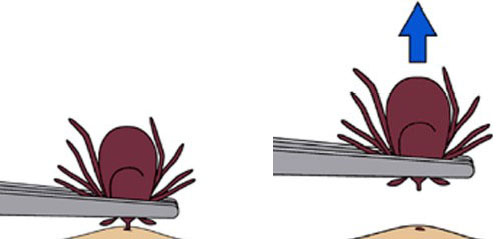
Fig. 12. Properly removing a large hard tick with tweezers. Image
courtesy of Centers for Disease Control and Prevention (CDC) .
For larger hard ticks: Use tweezers and grasp the tick as close to the skin as possible, targeting the mouthparts (Fig. 12). Carefully pull the tick straight upward without twisting or crushing it. Use steady pressure until it releases.
For smaller hard ticks: Scrape the tick with a knife blade or credit card edge, being careful not to cut yourself.
If the head accidentally breaks off and remains in your skin, clean the area around the bite and use a sterile needle to lift or scrape the head from the skin carefully.
Wash the wound and your hands with soap and water after removal. Apply an over-the-counter antibiotic ointment to help reduce the chance of catching a tick-borne disease or secondary infection.
Once the tick has been removed, save it in rubbing alcohol in case symptoms develop; tick identification is helpful for a diagnosis. Monitor the bite and watch for any signs of a rash or fever. If symptoms do develop, see a doctor. Inform the doctor of the recent tick bite, when it occurred, and where you most likely acquired the tick. Detecting a pathogen early can aid in faster treatment and recovery.
In addition to tick-vectored diseases, a rare condition known as tick paralysis can occur when a tick remains attached and feeds for a long time. This paralysis starts at the feet and moves up the body. It is caused by substances in the saliva injected into the body during feeding. It is completely reversible when the tick is removed, but can, in severe cases, when the tick is not removed, cause respiratory failure and death.
Table 1. Common tick-transmitted diseases in Utah
| Disease | Pathogen | Vector(s) | Symptoms |
|---|---|---|---|
| Rocky Mountain spotted fever |
Rickettsia rickettsii | Rocky Mountain wood tick (Dermacentor andersoni); Brown dog tick (Rhipicephalus sanguineus); Winter fern tick (Dermacentor albipictus) |
Sudden onset of chills and fever, headache, bloodshot eyes; leakage of blood from capillaries over the entire body. |
| Tularemia | Francisella tularensis | Rocky Mountain wood tick (Dermacentor andersoni) |
Chills, fever, prostration, ulceration at bite location, and tender, swollen lymph nodes. |
| Colorado tick fever |
Orbivirus | Rocky Mountain wood tick (Dermacentor andersoni) |
Sudden onset, intermittent fever, headache, muscular pain, leukopenia. |
| Tick paralysis | Saliva toxin | Rocky Mountain wood tick (Dermacentor andersoni) |
Paralysis spreading from feet to upper regions of the body; may cause death if tick is not removed. |
| Tick-borne relapsing fever |
Borrelia hermsii; Borrelia parker |
Soft ticks (Ornithodoros spp.) | Episodes of fever, headache, muscle and joint pain; nausea. |
| Lyme disease* | Borrelia burgdorferi | Western blacklegged tick (Ixodes pacificus) |
Fever, chills, headache, fatigue, muscle and joint aches, swollen lymph nodes; erythema migranes rash (target-shaped rash occurring at attachment site). |
*Lyme disease has not been shown to occur endemically in Utah tick populations.
Lime Disease in Utah
It is important to understand that not all ticks can transmit Lyme disease. In Utah, the western blacklegged tick (WBLT) (Ixodes pacificus) is capable of transmitting Lyme disease (Borrelia burgdorferi) to humans. However, the most commonly encountered tick in Utah, the Rocky Mountain wood tick, does not transmit Lyme. Additionally, not all WBLTs carry Lyme. In California and Arizona, where Lyme has been confirmed, only 4.9% to 14.6% of larvae and 1% to 5.7% of adult WBLTs carry Lyme (Eisen et al., 2010; Holden et al., 2003; Olson et al., 1992).
In Utah, Davis et al. (2015) surveyed 160 sites in northern and southern Utah over a 3-year period by flag/drag sampling. During that period, only 119 WBLTs were collected. Ninety-five percent (114 ticks) of the collected ticks were taken from a few isolated sites in the Sheeprock Mountains (Tooele County), demonstrating the rarity of encountering WBLTs in Utah.
All 119 adult WBLTs were tested for the presence of B. burgderfori (Lyme) using DNA tests. All 119 WBLT DNA extracts tested negative for B. burgderfori. While more research is needed to determine the status of Lyme in Utah, this research suggests that encountering a WBLT in Utah is rare and that it would be exceedingly rare for that tick to be a carrier of Lyme disease. The Rocky Mountain wood tick and winter fern tick were commonly collected throughout the general survey area.
Testing
Regardless of the risk, always practice sound tick safety procedures and conduct thorough tick checks to avoid contracting tick-borne diseases. Remember, different ticks carry different diseases, so properly collect and store any tick that has bitten you in case symptoms develop.
The lab is not equipped to handle and cannot accept physical samples of any tick that has come in contact with human fluids, nor can the lab test a tick for the possible pathogens it may contain.
For an analysis of tick-borne diseases, a few labs around the country specialize in tick disease testing. Visit these sites for more information on tick testing:
- Pennsylvania Tick Research Lab
https://www.ticklab.org/ - TickReport
https://www.tickreport.com/ - Ticknology
https://www.ticknology.org/tick-testing
References
- Centers for Disease Control and Prevention (CDC). (2021, October 21). Ticks. U.S. Department of Health and Human
Services. https://www.cdc.gov/ticks/index.html - Cranshaw, W. S., Peairs, F. B., & Kondratieff, B. C. (2019). Colorado ticks and tick-borne diseases [Fact sheet 5.593]. Colorado
State University Extension. https://extension.colostate.edu/topic-areas/insects/colorado-ticks-and-tick-borne-diseases-5-593/ - Davis, R. S., Ramirez, R. A., Anderson, J. L., & Bernhardt, S. A. (2015). Distribution and habitat of Ixodes pacificus (Acari:
Ixodidae) and prevalence of Borrelia burgdorferi in Utah. Journal of Medical Entomology, 52(6), 1361–1367. https://doi.org/10.1093/jme/tjv124 - Eisen, R. J., Eisen, L., Girard, Y. A., Fedorova, N., Mun, J., Slikas, B., Leonhard, S., Kitron, U., & Lane, R. S. (2010). A spatially explicit model of acarological risk of exposure to Borrelia burgdorferi-infected Ixodes pacificus nymphs in northwestern
California based on woodland type, temperature, and water vapor. Ticks and Tick-Borne Diseases, 1(1), 35–43. https://doi.org/10.1016/j.ttbdis.2009.12.002 - Fairclough, C. (n.d.). Tickborne diseases. Bureau of Epidemiology, Utah Department of Health and Human Services.
https://epi.health.utah.gov/tickborne-diseases/ - Holden, K., Boothby, J. T., Anand, S., & Massung, R. F. (2003). Detection of Borrelia burgdorferi, Ehrlichia chaffeensis, and
Anaplasma phagocytophilum in Ticks (Acari: Ixodidae) from a Coastal Region of California. Journal of Medical Entomology,
40(4), 534–539. https://doi.org/10.1603/0022-2585-40.4.534 - Locher, L. (2021). How to protect yourself from ticks [Fact sheet]. Oregon State University Extension.
https://extension.oregonstate.edu/gardening/techniques/how-protect-yourself-ticks - Olson, C. A., Cupp, E. W., Luckhart, S., Ribeiro, J. M. C., & Levy, C. (1992). Occurrence of Ixodes pacificus (Parasitiformes:
Ixodidae) in Arizona. Journal of Medical Entomology, 29(6), 1060–1062. https://doi.org/10.1093/jmedent/29.6.1060 - Piesman, J., & Eisen, L. (2008). Prevention of tick-borne diseases. Annual Review of Entomology, 53(1), 323–343. https://doi.org/10.1146/annurev.ento.53.103106.093429
- Walker, A. R. (2009). Bowman A, Nuttall P: Ticks: Biology, disease and control. Parasites & Vectors, 2(1), 1. https://doi.org/10.1186/1756-3305-2-1
Image Credits
1 Centers for Disease Control and Prevention (CDC)
2 Ryan Davis, Utah State University
3 Ryan Davis, Utah State University
4 Lyle J. Buss, University of Florida
5 Whitney Cranshaw, Colorado State University, Bugwood.org
6 Ryan Davis, Utah State University
7 Ryan Davis, Utah State University
8 Jim Occi, BugPics, Bugwood.org
9 Ryan Davis, Utah State University
10 Jim Occi, BugPics, Bugwood.org
11 Centers for Disease Control and Prevention (CDC)
12 Centers for Disease Control and Prevention (CDC)

